We explore the explosive science of volcanoes this week! We find out what you can learn from drilling into a restless volcano, how gravity is used to "weigh" volcanoes and watch them fill with magma, and we explore the theories behind volcano formation. Plus, we hear about the genes that could mean you'll live to be 100, fossil evidence of the earliest multi-cellular organism and the signs that Sabre-toothed tigers packed a mighty punch, as well as a big bite. In Kitchen Science, we get messy with a cola and wallpaper paste eruption!
In this episode
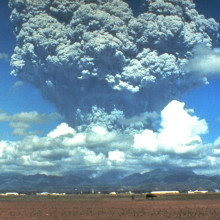
Wallpaper paste volcanoes - why some volcanoes go bang!
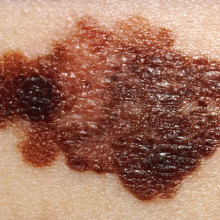
01:51 - Scientists discover melanoma stem cells
Scientists discover melanoma stem cells
In the world of cancer research, there's growing evidence for cancer stem cells - rogue stem cells that fuel the growth of tumours. When they divide, cancer stem cells produce new stem cells as well as so-called 'bulk' tumour cells. Treatments like radiotherapy and chemotherapy kill off the bulk cells, but don't touch the stem cells, so they carry on growing and the cancer returns. Stem cells have been found in many types of cancer, including breast and bowel cancer, and leukaemia. And now researchers at Stanford University School of Medicine in the US have found them in melanoma - the most dangerous form of skin cancer. Their research was published this week in the journal Nature.
 Led by Alexander Boiko, the researchers were studying the protein molecules on the surface of cells taken from melanoma samples. They found that between 2.5 and 41 per cent of cells had a protein called CD271 on their surface. Using a technique called flow cytometry, they were able to separate out cells carrying this protein, and test their properties.
Led by Alexander Boiko, the researchers were studying the protein molecules on the surface of cells taken from melanoma samples. They found that between 2.5 and 41 per cent of cells had a protein called CD271 on their surface. Using a technique called flow cytometry, they were able to separate out cells carrying this protein, and test their properties.
The researchers transplanted human melanoma cells into mice, comparing cells that carried CD271 with cells lacking the protein. They discovered that cells with CD271 were much more likely to grow into tumours than cells without the protein, suggesting they may have stem cell-like properties.
Here's the clever bit - when the researchers analysed cells from tumours grown from the CD271-positive cells, they found a mixture of human cells - some carried the protein, while others didn't. This told them that the CD271 cells were not only making more stem cells, but making bulk tumour cells too - a classic giveaway of stem cell behaviour.
The discovery of these stem cells helps to explain why many melanomas don't respond to immunotherapy - a treatment that harnesses the patient's immune system to destroy cancer cells. The team discovered that the melanoma stem cells lacked certain proteins that are targeted by current immunotherapy approaches, so the body's immune system can't recognise and kill them, and the cancer comes back.
But now we know that the stem cells do carry CD271, researchers can start working on treatments that target that CD271, or other proteins that are specific to the stem cells. This could lead to powerful new treatments for melanoma that are so urgently needed.

04:50 - Genes for centenarians
Genes for centenarians
Scientists have identified a series of genetic markers capable of predicting, with 77% certainty, who will live to more than 100.
 The study, by Boston University researcher Paola Sabastiani and her colleagues and published in Science, looked at DNA from over 1055 centenarians (who survived beyond the ages of 95-119) and 1267 controls (amongst whom the average age of death was 75).
The study, by Boston University researcher Paola Sabastiani and her colleagues and published in Science, looked at DNA from over 1055 centenarians (who survived beyond the ages of 95-119) and 1267 controls (amongst whom the average age of death was 75).
By comparing the patterns of genetic markers called SNPs - single nucleotide polymorphisms - that are common to the members of each group, the researchers identified 150 such SNPs that strongly co-segregated with longevity.
Applying these markers as a screen to other samples showed that they could predict, with high accuracy, those equipped genetically to live to a very old age. Moreover, these SNPs can now also be used to spotlight genes that confer these abilities, informing our understanding of the genetic basis of ageing, its effects, and perhaps how to better control it.
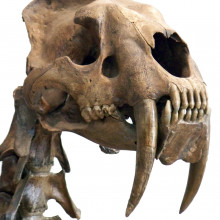
07:38 - Never arm-wrestle a sabre-toothed tiger
Never arm-wrestle a sabre-toothed tiger
Far from being cute kitties, sabre-toothed tigers were lethal hunters, roaming North and South American until around 10,000 years ago, searching for bisons, camels and other unfortunate animals. Today we know them for their super-sized teeth - they had exceptionally large canines for biting their prey. Now new research published in the journal PloS One suggested that there's more to these feline killing machines than their teeth.
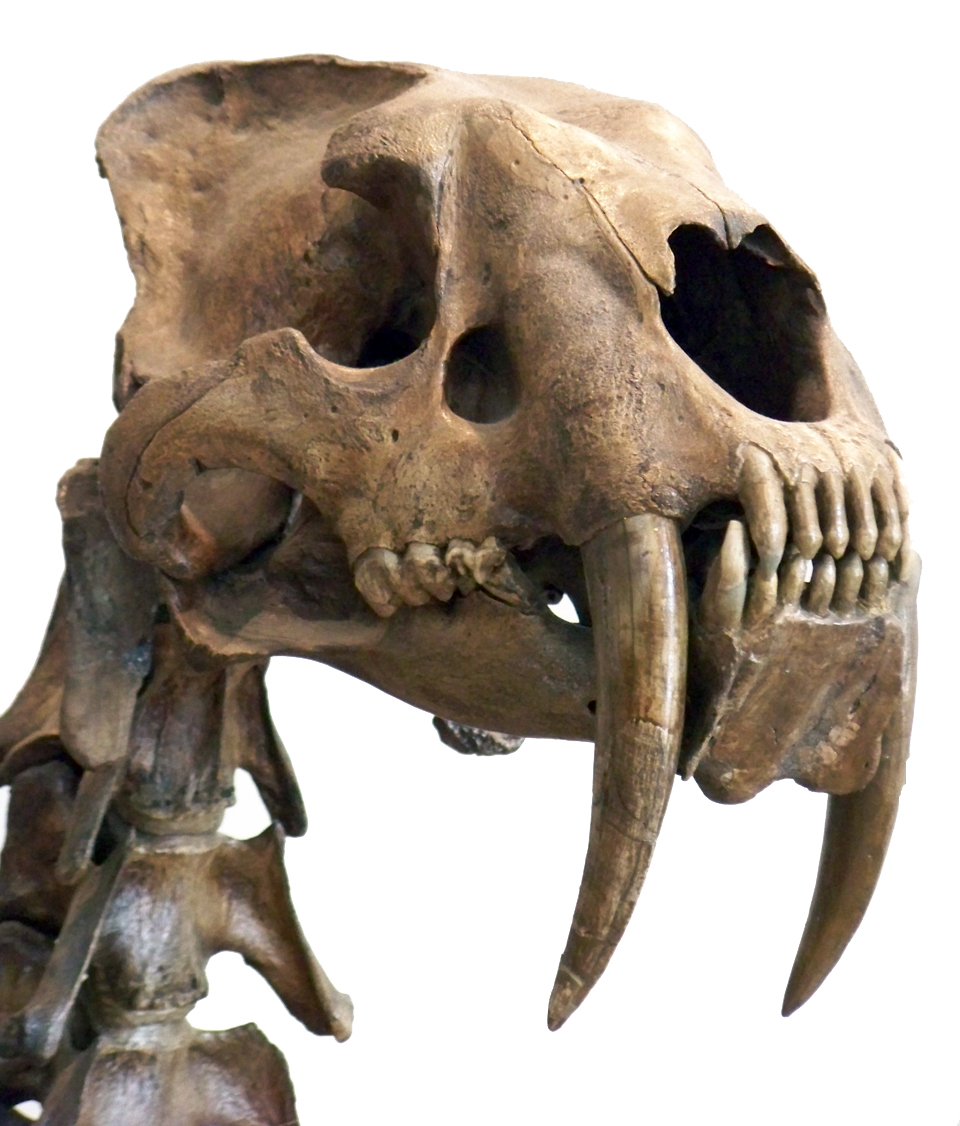 This is work from Julie Meachen-Samuels and her team in the US, who've been looking at sabre-tooth fossils. They noticed that sabre-tooth tiger canine teeth are oval in cross-section, unlike modern cats, whose teeth are round. Having oval-shaped teeth makes them vulnerable to fracturing and breaking if the animals prey is wriggling - not a good thing for a hunting cat. This led the researchers to think that sabre-tooths may have killed their prey in a different way to modern cats, and not relied quite so much on their impressive teeth.
This is work from Julie Meachen-Samuels and her team in the US, who've been looking at sabre-tooth fossils. They noticed that sabre-tooth tiger canine teeth are oval in cross-section, unlike modern cats, whose teeth are round. Having oval-shaped teeth makes them vulnerable to fracturing and breaking if the animals prey is wriggling - not a good thing for a hunting cat. This led the researchers to think that sabre-tooths may have killed their prey in a different way to modern cats, and not relied quite so much on their impressive teeth.
The researchers measured bones from the fore-limbs of sabre-tooth tigers, and compared them with 28 other cat species living today, from a tiny cat to a tiger. They found that the sabre-tooth limbs were much chunkier and stiffer than expected, with prominent muscle-attachment sites on the bones. This suggests that sabre-tooth tigers had exceptionally powerful and strong forelimbs, compared to today's cats.
The scientists think that sabre-tooth tigers may have used their muscular forelimbs to immobilise their prey, before biting into them. This would have protected their vulnerable teeth, and built up their arms even more. Today's cats have stronger teeth, and weaker forelimbs, so they probably rely more on their teeth for hunting than their ancestors.
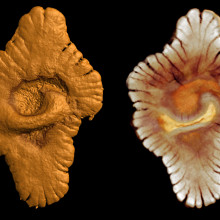
09:45 - Oldest evidence for multi-celled life discovered
Oldest evidence for multi-celled life discovered
Scientists working in West Africa have uncovered an incredible clutch of fossils that appear to represent the earliest ever remains of complex life.
The discovery, published in Nature by University of Poitiers, France, researcher Abder El Albani, contains dramatic photographs of the 1cm diameter organisms that were discovered in in southeast Gabon encased in sedimentary rocks, determined isotoptically to be over 2.1 billion years old.
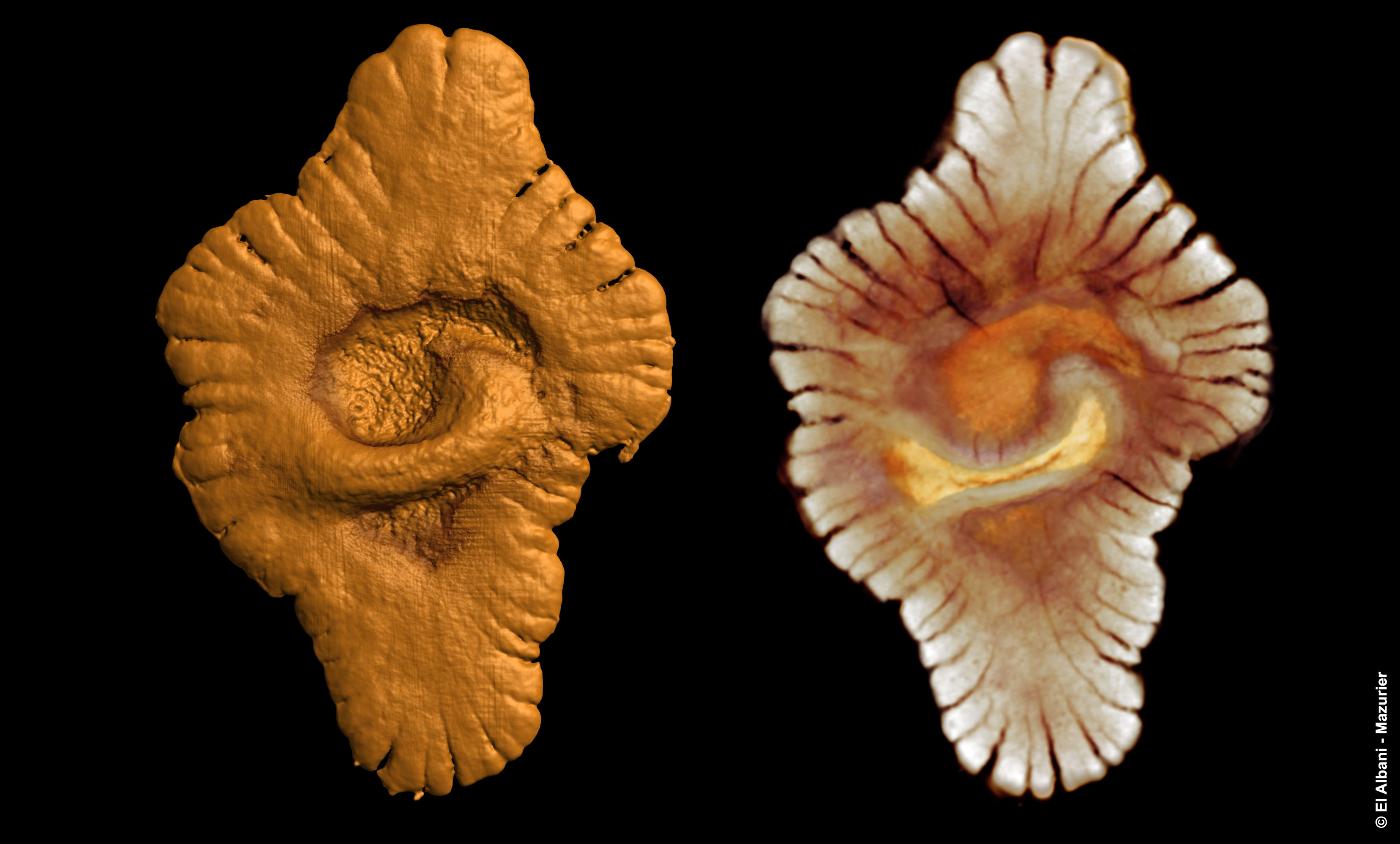 The fossils, which appear to consist of cooperating colonies of cells, macroscopically resemble fried eggs with a central "body" surrounded by flat sheets or lamellae of tissue which is further divided by a pattern of radial slits. The arrangement of the material suggests that these creatures were growing by adding tissue to their periphery and functioning as a multicellular organism. They do not resemble anything observed previously from this epoch.
The fossils, which appear to consist of cooperating colonies of cells, macroscopically resemble fried eggs with a central "body" surrounded by flat sheets or lamellae of tissue which is further divided by a pattern of radial slits. The arrangement of the material suggests that these creatures were growing by adding tissue to their periphery and functioning as a multicellular organism. They do not resemble anything observed previously from this epoch.
The fossils also contain the chemical signature of sterane, a sterol derivative which is regarded as a hallmark of eukaryotic life, indicating that these organisms were distinct from the more primitive prokayotic life known to have gone before.
Even more intriguing, analysis of the iron composition of the fossilised material also suggests that they were oxygen-using organisms, which fits with the fact that they date from about 200 million years after the "Great Oxidation Event," when the Earth suddenly went aerobic.

12:08 - Coring an Atom with an X-Ray Laser
Coring an Atom with an X-Ray Laser
with Dr. Linda Young, Argonne National Laboratory
Chris - Now also this week, researchers in America have used a very powerful x-ray laser to strip away the electrons from an atom of neon. But they also have been able to very carefully strip away only those electrons which are closest to the atom's centre, creating the atomic equivalent of a cored apple. Dr. Linda Young is a distinguished fellow of Argonne National Laboratory which is just outside Chicago and she's with us to tell us how it works. Hello, Linda.
Linda - Hello.
Chris - Welcome to the Naked Scientists. Do tell us if you could, first of all, what is this laser and why is it so special?
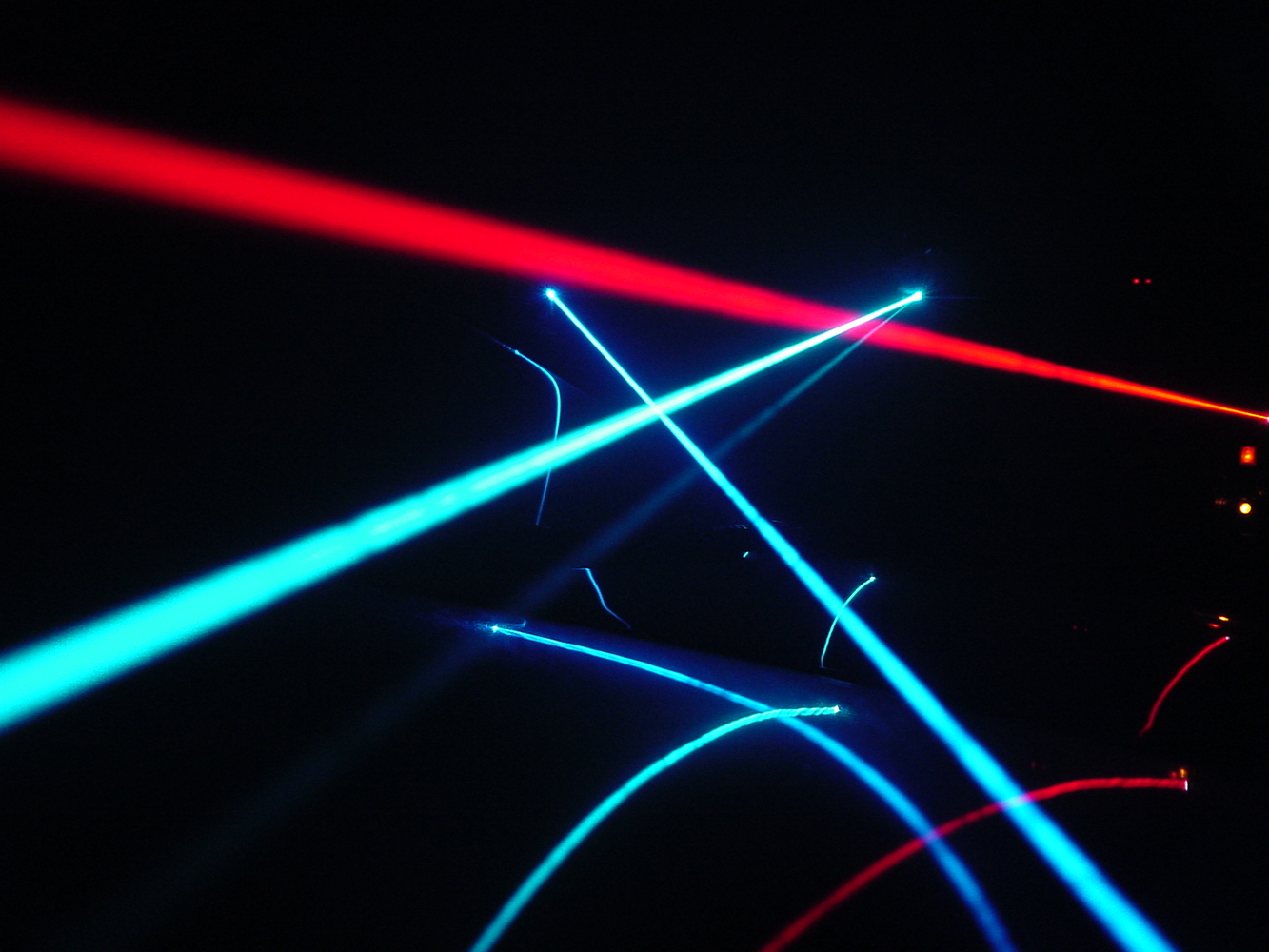 Linda - This is the world's first hard x-ray free electron laser and it produces x-rays that are about a billion times more intense than any other x-ray source before. The intensity is actually equivalent to taking all of the sun's radiation on earth and putting it into 1 square centimetre. So it's an exceedingly powerful x-ray laser.
Linda - This is the world's first hard x-ray free electron laser and it produces x-rays that are about a billion times more intense than any other x-ray source before. The intensity is actually equivalent to taking all of the sun's radiation on earth and putting it into 1 square centimetre. So it's an exceedingly powerful x-ray laser.
Chris - And obviously, you wouldn't use this clinically, but you can use this to probe things like atoms of very, very high resolution. So tell us how you're doing that.
Linda - Yes, that's right. Because this laser is so intense, and all these photons come in such small bursts, you are in fact able to capture motion on the atomic molecular scale within femtoseconds. That's about the time that it takes for molecules to vibrate within larger structures such as proteins. But because we had such an intense laser, and it's the first time anyone had had it, one really wants to understand how that very intense x-ray beam interacts with matter. And so, you might think that if you take a trillion photons and focus it down to a micron or so, you couldn't control at all what's going on in matter. But in fact, we find that we can control how the matter responds by tuning the photon energy of the x-rays, and by tuning the pulse duration in which you deposit those x-ray photons into the atom.
Chris - So tell us about the experimental set up just briefly. What did you actually do?
Linda - Okay, so you take this very intense x-ray beam and you focus it down to about a square micron, into a jet of neon atoms.
Chris - So that's a millionth of a metre we're talking here, isn't it? A thousandth of a millimetre across.
Linda - That's right. And when you do that, you surround that interaction region with a number of detectors that can detect all the products of the reaction. And so, you can detect all the ions that are produced and all the electrons that are produced, and by having these very high resolution detectors, you can tell exactly the mechanism by which the neon atom becomes stripped of its electrons.
Chris - So you fire these very intense x-ray beams into a cloud of atoms and you spray neon, so that's a noble gas, isn't it - very unreactive. What happens to the atoms when they hit with this very intense burst of x-rays?
Linda - Well, that depends on what photon energy you've selected. You can select the photon energy where you hit out the inner electrons first or you can select a photon energy where you just peel away the outer electrons. So, depending on where you are in photon energy, you can do one or the other.
Chris - And how does this inform our understanding of physics and our understanding of atomic structure?
Linda - Actually, what it informs you of is how very intense x-rays interact with matter. Before this x-ray laser was available, we were only ever able to knockout one of the inner electrons in a shot, but now with this very intense x-ray laser, you can knockout both of the inner electrons simultaneously, and that leaves you with this so-called hollow atom or cored atom. That hollow atom has different properties than a normal atom including the possibly advantageous property that when the inner electrons are missing, then the x-ray absorption is decreased, relative to the scattering cross-section, and the scattering cross-section is what forms an image for you to make further molecular movies or images of complex molecules. So, what I would say is that we're just exploring a new regime of x-ray interactions with matter.
Chris - Which is of course going to give you the opportunity to begin to understand and probe whole molecules at a kind of resolution and in a way that we've never seen before. Linda, thank you very much. That's Dr. Linda Young who is from Argonne National Laboratory and she's published that work in the journal Nature this week.
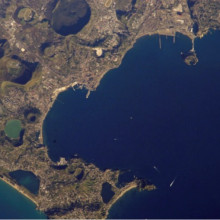
17:12 - Drilling Deep Into a Restless Volcano
Drilling Deep Into a Restless Volcano
with Dr. Chris Kilburn, University College London
Kat - We're joined by Dr. Chris Kilburn from University College London. He's doing something that may be only associated with James Bond baddies or Dr. Evil. He is drilling into a volcano. Now I take it Chris, you're not making a secret underground layer, but tell us about this volcano. Where is it? Why is it interesting and why are you drilling into it?
Chris K. - Well of course we're arranging to take over the world with our secret schemes clearly.
Kat - I thought so!
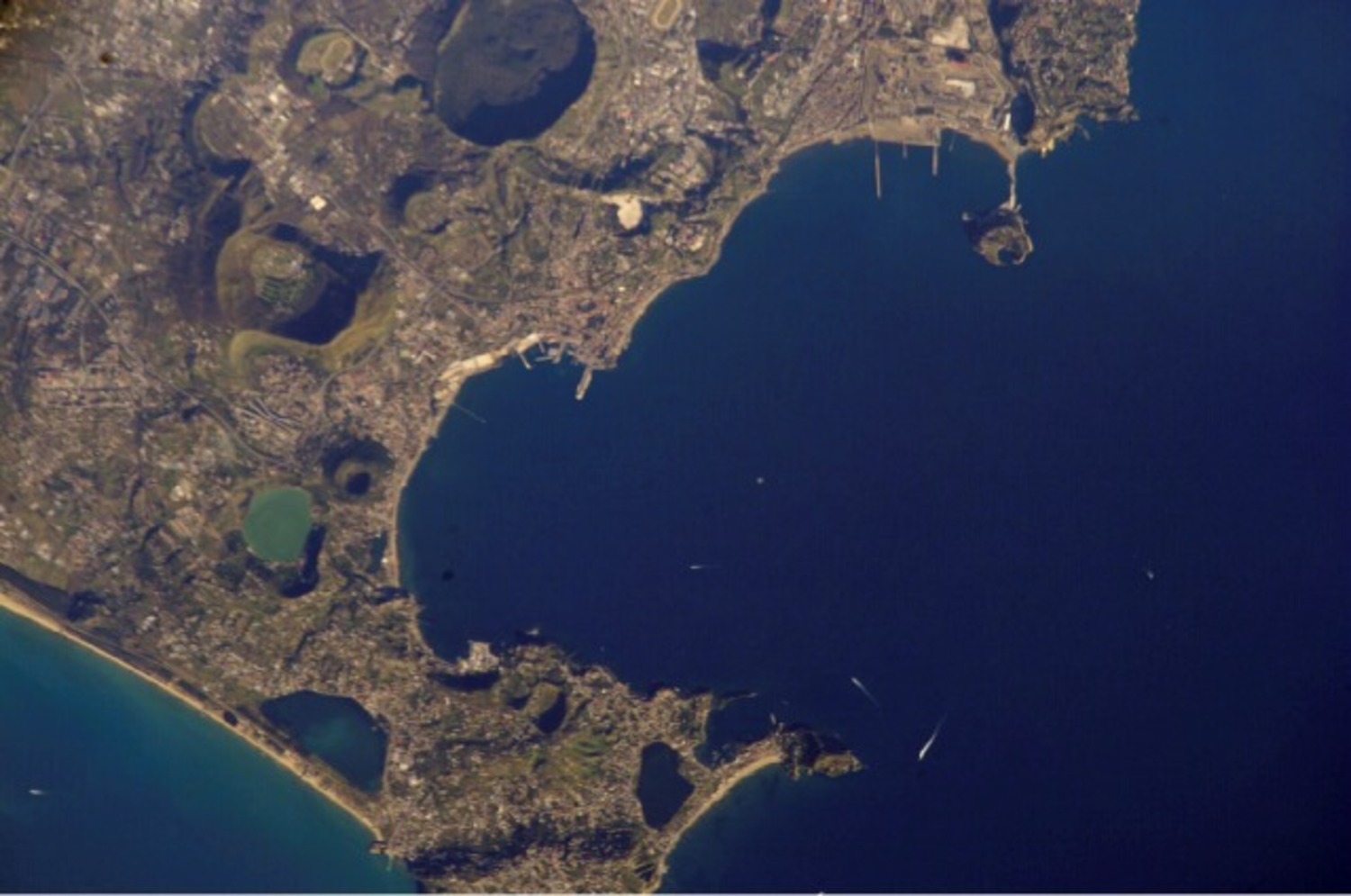 Chris K. - Campi Flegrei is a caldera. It's a large volcanic complex immediately to the west of Naples in southern Italy. Rather than your typical pointy volcano, it's actually - when you arrive there, it looks like a flat plain which is then dotted with small cones across it's 12 kilometres diameter, and it formed about 15 and a half thousand years ago after a large eruption released several tons of cubic kilometres of magma, and the ground simply sank into the hole that was left behind. Why we're interested in it in particular is because the Campi Flegrei - the west part of Naples is actually inside the caldera and there are another about 250,000 to 300,000 people in the surrounding districts, also living within the caldera itself. And for the past 40 years, it has shown significant signs of unrest, so the central part of the caldera, a town called Pozzuoli or rather a port, today has risen 3 metres with respect to where it was in the late 1960s. And so, this was some concern that this may be one signal that an eruption may be imminent. Imminent - meaning, sometime within perhaps the next 100 years or so.
Chris K. - Campi Flegrei is a caldera. It's a large volcanic complex immediately to the west of Naples in southern Italy. Rather than your typical pointy volcano, it's actually - when you arrive there, it looks like a flat plain which is then dotted with small cones across it's 12 kilometres diameter, and it formed about 15 and a half thousand years ago after a large eruption released several tons of cubic kilometres of magma, and the ground simply sank into the hole that was left behind. Why we're interested in it in particular is because the Campi Flegrei - the west part of Naples is actually inside the caldera and there are another about 250,000 to 300,000 people in the surrounding districts, also living within the caldera itself. And for the past 40 years, it has shown significant signs of unrest, so the central part of the caldera, a town called Pozzuoli or rather a port, today has risen 3 metres with respect to where it was in the late 1960s. And so, this was some concern that this may be one signal that an eruption may be imminent. Imminent - meaning, sometime within perhaps the next 100 years or so.
Kat - Crumbs! So, you're drilling into a volcano to find out more about it. Tell us a bit about how you go about drilling into a volcano and then the sort of things that you're looking for once you've done your drilling.
Chris K. - Well the type of drilling is fairly similar, the technology is very similar, to that used for drilling for oil. Of course, that's not the best analogy used right now, but nevertheless, what we're particularly interested in is obtaining material down to depths of about 4 kilometres. The reason for that is because all the data that we have so far suggests that the unrest is being driven by changes somewhere at depths up to 4 kilometres below the surface, and we need samples to do experiments on to better understand the physical properties of the rocks, so that we have a better understanding of how it's likely to break as the whole crust continues to deform.
Kat - And what sort of changes are you looking for? What can you tell about a volcano? What it's up to from looking at these samples?
Chris K. - Well the samples themselves really - what we're going to look at are for example, the conditions, the stresses that have to be applied for them to break, how cracked they already are, whether it's possible for water to easily pass through the rocks, and all this information is needed to interpret seismic signals that we record normally at the surface, and also, to interpret for example, changes in the ground deformation, changes in gravity signals - as we'll discuss later. At the moment, we have to make best guesses for some key parameters and hopefully, thanks to the drilling, we will be able to be much more precise about the numbers that we stick into the models.
Kat - And the one thing that concerns me slightly is that you're drilling into a volcano. Is it safe? Is there any risk that you're going to sort of - wake it up or something?
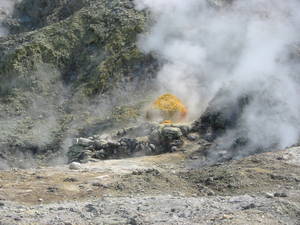 Chris K. - No. We don't think so. Not in this particular case. All the evidence points to the fact that there isn't any significant molten magma right now at shallow depths. What's happened is that if magma has been evolved, it's been small bodies of material that have pushed up to shallow levels and have now solidified. In any case, the diameter of the borehole is only a few 10's of centimetres across and it's extremely unlikely that magma will be able to force its way up from 4 kilometres up to the surface, even if we happen by mistake to actually meet some molten material, but that's really unlikely.
Chris K. - No. We don't think so. Not in this particular case. All the evidence points to the fact that there isn't any significant molten magma right now at shallow depths. What's happened is that if magma has been evolved, it's been small bodies of material that have pushed up to shallow levels and have now solidified. In any case, the diameter of the borehole is only a few 10's of centimetres across and it's extremely unlikely that magma will be able to force its way up from 4 kilometres up to the surface, even if we happen by mistake to actually meet some molten material, but that's really unlikely.
Kat - One of the things that we know in volcanic areas is that you can harness the heat from the volcanoes and you use things like geothermal energy to heat up water. Is that something that you're looking at that you could apply to the Campi Flegrei?
Chris K. - We will take advantage of that, having drilled a borehole here that has more purely scientific and hazard related motives. But you're quite right, once the whole has been made, it will be possible to look at the potential of hot water to percolate through the rock and extract it so the heat can be extracted from the water, and then it can be used for energy purposes. In the early 1980s, this was tried once before but the price of oil was so cheap in those days that it really wasn't economic to develop as a geothermal field. Of course, the economic conditions today are quite different. So, it may turn out that this particular borehole will also be used to evaluate whether it's worth developing the area as a geothermal resource.
Kat - How times have changed. It could be handy. And finally, how similar is the Campi Flegrei to other volcanoes around the world? Can you apply what you're finding out to other volcanoes and make predictions about them as well?
Chris K. - Well, there are several hundred caldera complexes across the world and somewhere of the order of 130 to 150 have been restless in the last 300 or 400 years. So, we certainly expect that we will be able to take some of our results and apply them more generally across the world. Other examples include Long Valley caldera in California, maybe Yellowstone, also in the United States, and Papua New Guinea, the Rabaul caldera, so to name just two or three.
Kat - And not scoping any of them out for a secret underground layer.
Chris K. - But I couldn't possibly tell you that on air, could I?
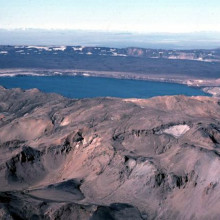
23:41 - Weighing Volcanoes with Gravity
Weighing Volcanoes with Gravity
with Dr. Hazel Rymer, Open University
Chris - The key to understanding the behaviour of a volcano must lie, partly at least, in understanding the plumbing system that brings magma from deep inside the earth up to the surface so that it can erupt. One way to do this is to observe the changes in the gravity field that occur over a volcano. And to explain more, we're joined by Dr. Hazel Rymer who is from the Open University. Hazel, welcome.
Hazel - Hello.
Chris - Thank you for coming to join us on the Naked Scientists. First of all, tell us how on earth do you use gravity to work out the plumbing of a volcano.
Hazel - Well, good question. It's not the most obvious thing to do, is it? Well, we use a very expensive piece of kit called a gravity meter. It looks a bit like an old car battery. It's a box with knobs on.
Chris - Sounds technical.

(c) NASA' alt='Gravity anomaly map' >Hazel - Very technical and very unimpressive, but they cost several tens of thousands of pounds actually. And what they are, basically, is a mass on the end of a spring inside them. So, it's a bit like the scales that you might see in any market, where you stick two or three apples into the scale pan and then the spring will extend, and the dial will move, telling you how far the spring has extended, that would tell you the weight of the stuff in the pan. What you're doing there is you're changing the mass, as in you're changing the number of apples in your pan, but you're keeping g, the acceleration due to gravity, constant or you're assuming it's constant.
What we do with the gravity meter is we keep our number of apples in our pan constant. In fact, in this particular case, it's a tiny, tiny little mass, about a gram or so. And what we're doing is, in a way, looking for how much the spring extends or doesn't extend in different places as we move our gravity meter around the volcano. And the variable in this case is not mass as in number of apples, but it's little g, the acceleration due to gravity. So, what we're doing, effectively, is seeing what the weight of our little scale pan inside our gravity meter is, as we move around the volcano. All you have to do is put it into your backpack and wonder around across your volcano and set up a series of stations - it could be anything between 10 and 100 points on the volcano - and you measure gravity at them.
Chris - Presumably, you use GPS so you know you're using the same or measuring the same spot each time...
Hazel - Yes. Well there are several ways of doing gravity actually and yes, you always do need to use GPS to locate yourself, but one way is simply to end up with a map of gravity. So, just as you end up with a contour map, that would just tell you the different heights in a particular area, so the lines would represent equal heights and you know, if you have lots of them very close together, then the terrain is very steep. That's a topographic map. You can have a gravity map that tells you how gravity varies with space. So for example, at the top of a volcano, you might find that there was what we call a gravity anomaly where gravity was particularly high or particularly low as the case may be, and you would see that by very close together isogals which are the contours related to gravity. But the other thing is to see how gravity changes through time.
Chris - That's what I was going to say because why should the gravity of a volcano change? Presumably, it's gaining mass from somewhere and that presumably is magma rising into or exiting the volcano, and this will affect how much it weighs - to use a horrible term in a physics sense, but it will affect its gravitational attraction for your box.
Hazel - Yes, exactly right. There are a lot of other things that you need to check and of course, that's why you use GPS and other methods because if the volcano inflates or deflates -
Chris [Kilburn] was just talking about Campi Flegrei which is - well, sometimes it sinks down and sometimes it rises because it's a caldera in a state of unrest, but for example, as a caldera deflates as it goes down, you on the surface of the earth actually get closer to the centre of the earth and that means that gravity will increase. So you have to be able to correct for that effect. Having done that, then any net change in gravity that you measure must be due to subsurface mass changes, and in the case of an active volcano, you would probably interpret that in terms of magma movements.
Chris - But getting back to the point you made which is the time one, many observations that are made of volcanoes are not made longitudinally. People don't go back to the same spot year on year, on year, and then get an accurate record of how that thing is evolving. Obviously, not on a geological timescale, but on a human time scale. Is that something you've been able to do then because you've been doing this for - I was looking at your publications - it goes back 20 years!
Hazel - I know. I was. It's just that I'm old!
Chris - I wasn't going to say that!...
Hazel - It is unusual to do it, yes. Not very many people have the opportunity and the privilege to keep revisiting several volcanoes for a long period of time, and actually, you do have to look at several volcanoes because most of them don't do anything most of the time.
Chris - Geologists must need to live longer. You need some of those genes that make you live to be 100...
Hazel - Absolutely right. Yes, that would be useful, wouldn't it? You still wouldn't live as long as a volcano unfortunately.
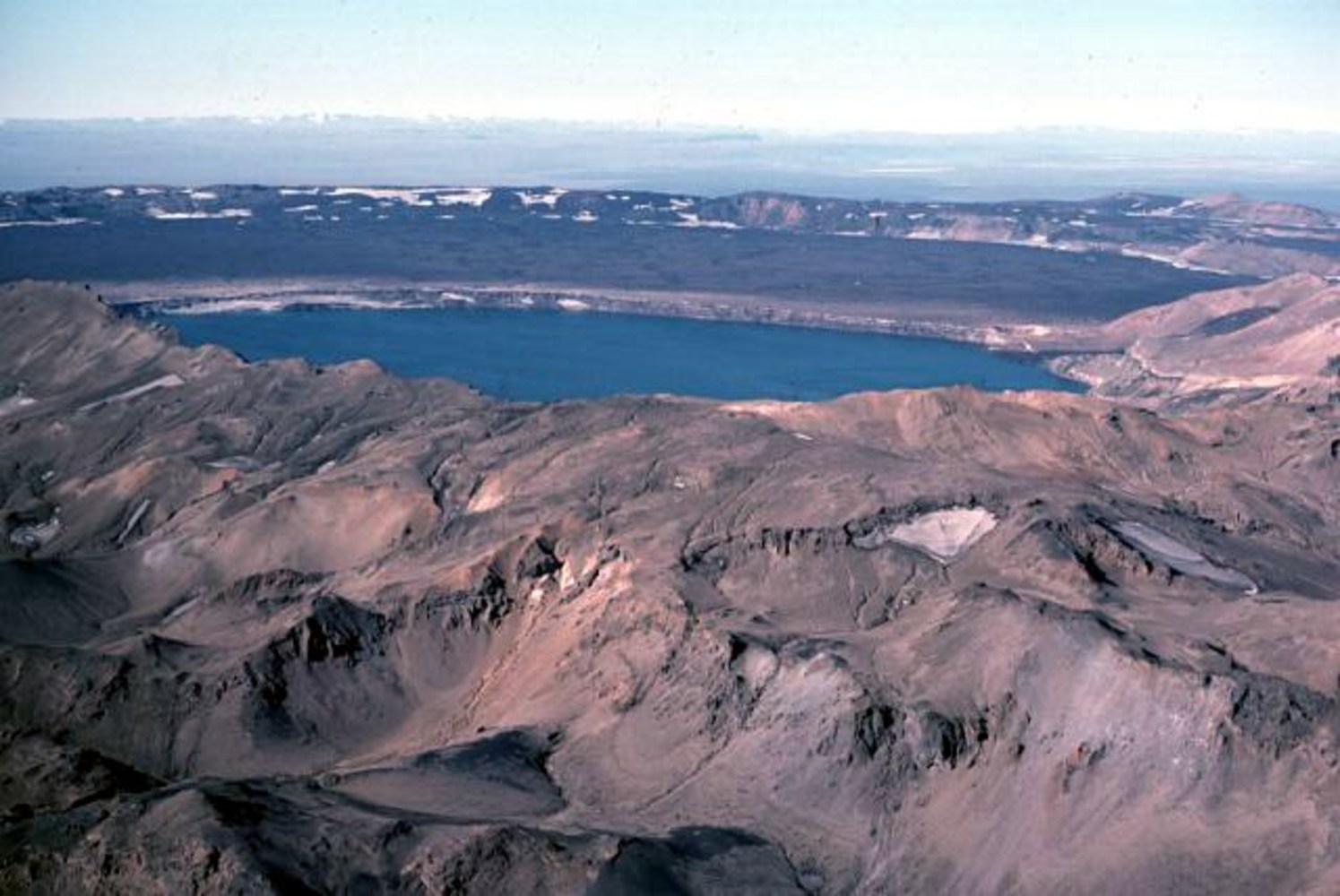 Chris - Ideally not. So you've been working in Iceland? This thing, this blessed thing that I'm not going to try and say the name of it but perhaps you can for me, but what have you found there?
Chris - Ideally not. So you've been working in Iceland? This thing, this blessed thing that I'm not going to try and say the name of it but perhaps you can for me, but what have you found there?
Hazel - Okay. Well, I've not been working on Eyjafjallajökull itself. I've been working on a volcano slightly further north than that and it has the advantage of not being covered up by an ice cap at the moment, so it's much easier to measure. And what I've been doing, first of all, I set up a gravity network on the volcano to look at the general structure of the volcano, so I had a gravity map as I described earlier. So started with that and from that, and of course the work of lots and lots of other people, we were able to see what the general structure underneath the volcano is and where the magma chambers are. So, as Chris was talking about Campi Flegrei, we think there are several pods of magma underneath the Campi Flegrei.
At Askja volcano - which is the one I've been looking at, more or less in the centre of the country - we think that there's a chamber or a storage reservoir of magma at about 3 kilometres depth, and another one, a little bit further down. So we work that out with among other things, the gravity surveying. And then going back to each of those stations year after, after year, as you say, and making corrections for the amount the ground has been deforming, we've been able to see that over the years - well, for the first 17 years of the study, there was a net mass loss of the volcano. In fact, what was going on was the ground was going down. It was deflating since the last eruption in 1961 and it looked as though magma was draining away from the volcano and that seems to have been what was going on until about 2007.
After that, the seismic activity changed a little bit and there was a lot of seismic activity, quite shallow, to the north of Askja volcano, and it was unclear from seismic activity. You can tell that magma is moving, you can't necessarily tell which way it's going. Our gravity measurements suggested that over 2008 and 2009 we've actually got an influx of magma coming back into the volcano. So, the mass underneath it has increased which is quite exciting.
Chris - Do you think that the activity we've seen this year in its partner, the one I can't say, do you think that's relevant then to this? Do you think that one could be a symptom of the other, if you like?
Hazel - Well never say never, but I don't think there has to be a connection. The volcanoes are several 10s of kilometres apart from each other and of course, the plumbing system is linked at huge depth, but they have separate feeder systems, so I don't think that there's likely to be a connection.
Chris - And just to finish this off, Hazel. Does the data that you've generated here inform our understanding of how volcanoes behave in general? In other words, does this tell us a bit more about what predictions we can make about their likely evolution over both human and geological timescales?
Hazel - Well I hope so. Otherwise, I don't why I've been doing this.
Chris - You may have you've got negative results. I don't know, you obviously haven't, but...
Hazel - Well yes, I think it does, but again, as Chris was saying earlier, there are lots of different types of volcanoes and he talked about the sort of pointy peak volcanoes and the flat ones, and the ones that are basically a whole in the ground. There's a huge variety of volcanoes and they all work in slightly different ways. There are a lot of variables to do with the thickness of the lithosphere, the crust that their coming up through, the chemistry of the magma. Sometimes it's very thick, sticky stuff, so it's harder for it to move around. They're are a huge number of variables and you need to understand all of those variables to be able to put together a sensible picture of how an individual volcano is working.
Chris - But you made a start and that's the most important thing.
Hazel - I've had a go.
Chris - Brilliant. Thank you very much, Hazel Rymer from the Open University.
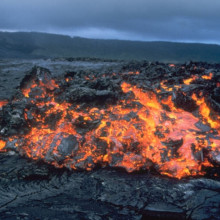
33:19 - Forming Volcanoes - A Geological Controversy
Forming Volcanoes - A Geological Controversy
with Professor Gillian Foulger, Durham University
Chris - We are talking all about the science of volcanoes this week, and to help us forecast an eruption, we need to understand as much as possible about the processes that cause a volcano to form in the first place, and we're joined now by Professor Gillian Foulger who works on understanding how volcanoes form in places like Hawaii. Gillian Welcome.
Gillian - Hello, Chris.
Chris - Welcome the Naked Scientists. Tell us if you would. First of all, how do volcanoes form and what are the areas of contention?
Gillian - Well, most volcanoes in the world occur along the edges of tectonic plates. So, most people are probably familiar with the concept that the Earth's surface is broken into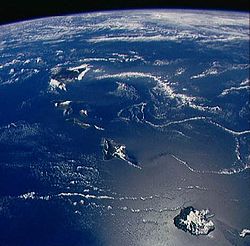 lots of plates like the shell of a tortoise, and along their edges where they move past one another, there are huge cracks going right through the lithosphere layer down into the Asthenosphere (outer mantle) below and molten material can leak up through these cracks and form volcanoes. So, the volcanoes such as Mount St. Helens and the cascades volcanoes, the volcanoes of Japan, they all occur along plate boundaries. There isn't too much controversy about how they form, but the real controversy lies with the volcanoes that form smack in the middle of plates...
lots of plates like the shell of a tortoise, and along their edges where they move past one another, there are huge cracks going right through the lithosphere layer down into the Asthenosphere (outer mantle) below and molten material can leak up through these cracks and form volcanoes. So, the volcanoes such as Mount St. Helens and the cascades volcanoes, the volcanoes of Japan, they all occur along plate boundaries. There isn't too much controversy about how they form, but the real controversy lies with the volcanoes that form smack in the middle of plates...
Chris - Can you give us some example of those?
Gillian - Well, an example is Tristan da Cunha, Reunion Island, people also interestingly enough put Iceland in that category, and of course, Hawaii.
Chris - Okay, so these are volcanoes that pop up in the middle of a plate. So what goes at the margin of a plate or plate boundary cannot go for what's going on in the middle. So what do scientists think is driving the emergence of a volcano at that point then?
Gillian - Well, there are two competing hypothesis. There's the plate hypothesis which says, "Hang on, plates are not completely rigid. That's just like a cartoon world." Geology is much more complicated than that, and huge plates do have cracks, they do pull apart in their middles, and we can have the occasional volcano that comes up through the crack in the middle of a plate.
The competing hypothesis is the traditional plume hypothesis which suggests that you have a hot diapir, a hot thermal coming out from the Earth's core, rising 3,000 kilometres through the Earth's mantle and punching its way through the plate at the surface, not caring whether it's in the middle of a plate or not.
Chris - Have we any idea as to why such a pulse of energy should be unleashed by the core in that way? Why should that happen and why don't we see this more extensively then?
Gillian - Well that's a very good question, Chris, because you often hear people say - Hawaii is a typical example of a plume, but in fact, Hawaii is completely unique on the Earth's surface. There isn't anything else like it anywhere. But coming back to your original question - why should this happen - people have suggested, people have pointed out that the earth's core is about 1,000 degrees hotter than the material immediately above. So they have this model like a kettle on a stove with a hotplate underneath and the hotplate is heating water in the kettle, and causing diapirs to rise up. So, that's the fundamental concept behind that theory.
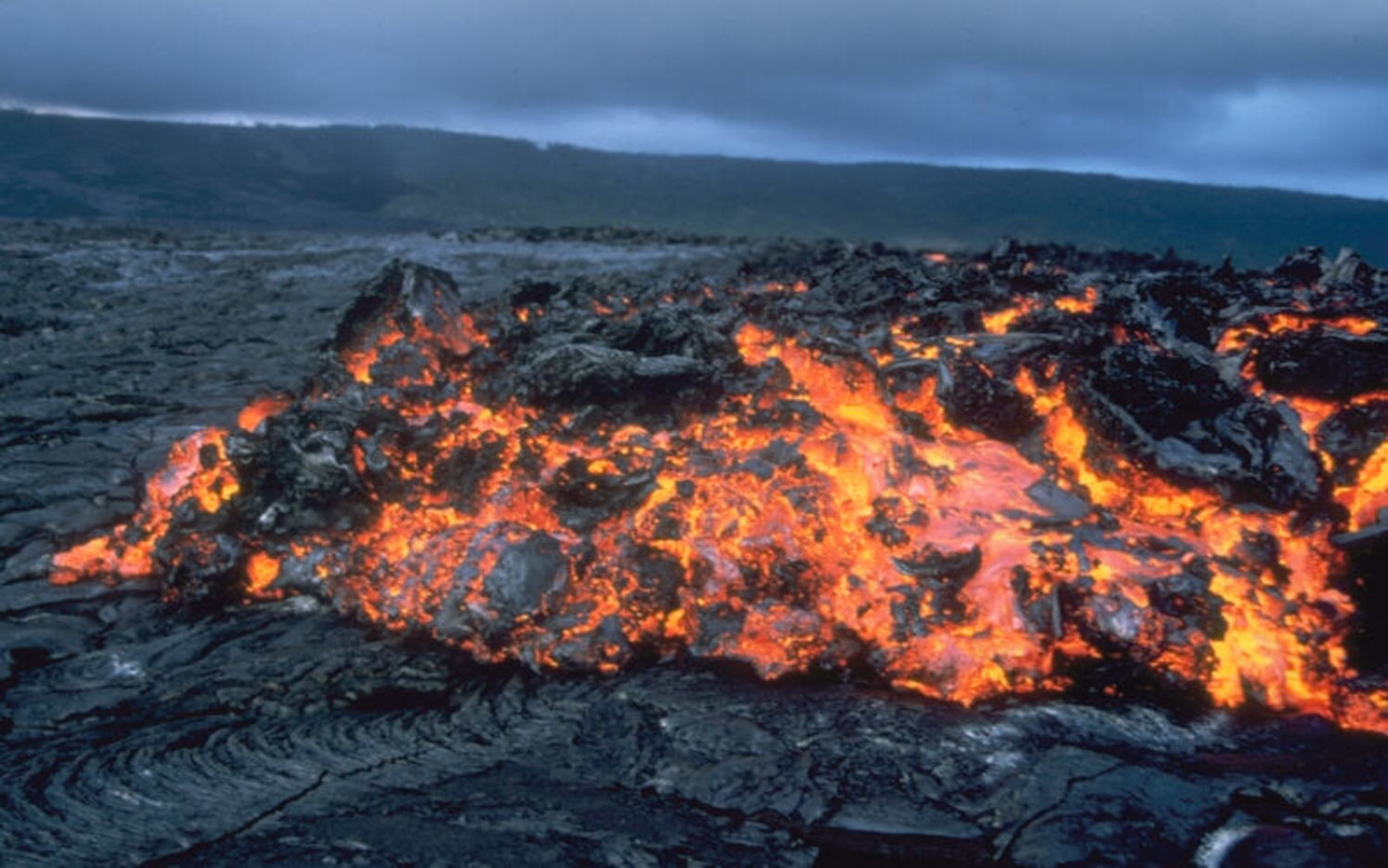 Chris - So it's almost like a weak spot and the energy gets focused somewhere, and as soon as something gives, then it gets channelled up through whatever that weakness is, and that just happens to be say, Hawaii. There must be other examples of these plumes, like the ones you gave where this energy is unleashed, but how can we resolve that question? How can we study this? It's not trivial to get into a planet that's got a radius of 6,000 kilometres and find out what's going on in the middle. How can we address this problem?
Chris - So it's almost like a weak spot and the energy gets focused somewhere, and as soon as something gives, then it gets channelled up through whatever that weakness is, and that just happens to be say, Hawaii. There must be other examples of these plumes, like the ones you gave where this energy is unleashed, but how can we resolve that question? How can we study this? It's not trivial to get into a planet that's got a radius of 6,000 kilometres and find out what's going on in the middle. How can we address this problem?
Gillian - Well one of the primary methods used is using earthquake waves to CAT scan the Earth. So, when earthquakes occur, rays go through all parts of the Earth and we have seismometers on the surface, so this is like taking a person into a hospital and CAT scanning them. We can look at the structure inside the Earth. And what we're really looking for is to see if under places like Hawaii and Iceland, if we see some kind of a structure going all the way from the surface right down the Earth's core, and if we saw that, that would pretty much be strong evidence in favour of the plume hypothesis.
Chris - So what have you seen? You presumably haven't seen that yet. So what have you seen?
Gillian - No. What we tend to see almost everywhere is structures which can go down several hundred kilometres, but they don't go down the full 3,000 kilometres that they would have to do to reach the core.
Chris - So do you think it's just a question of making more observations or do you think we need to rethink this model and in fact, you don't need to go all the way down to the core? Perhaps it can act as a sort of vent for pressure slightly outside the Earth's core.
Gillian - Yes. I think we don't need to go down to the Earth's core. I think everything is happening just in the upper 3, 4, 5, 600 kilometres. It's not going all the way down 3,000 kilometres to the core. But regarding how do we address this problem, well, part of the reason why this controversy is so exciting is because a lot of things - a lot of human aspects are weaving in which almost stand outside the science. The plume hypothesis has been popular for a very, very long time and there's great reluctance to let it go partly because it can sort of be trotted in to explain everything. Whatever you see or you don't see, you can find some way of turning the plume hypothesis around to explain that. But the plate hypothesis on the other hand makes specific predictions which we should be able to go out and test. So, there's great excitement in the geological community at the moment and some people say this is the most exciting and fundamental controversy that's developed since plate tectonics.
Chris - So obviously, we will be in a position at some point in the future to make reasonable predictions about volcanic activity at plate margins where one plate is either subducting or overriding another, but if we've got this problem with plume volcanoes, how can we predict those? If we don't understand what's causing them in the first place, how can we predict their activity?
Gillian - This subject is really looking at big scale and long term volcanic behaviour. So, unlike
what Hazel (Rymer) was describing, Hazel is looking at the activity of specific volcanoes on the kind of timescales that are relevant to human beings a few years or a few decades. But we're looking at the big scale of things and we're looking on timescales of millions of years. So the sort of problem we would be interested in that we could contribute to would be when Kilauea in Hawaii becomes extinct, where is the next volcano going to form.
Chris - And presumably also, you're in a position to inform the climate change debate because we know that volcanoes and volcanism have had a big contribution to the Earth's atmospheric composition over many, many years, and understanding this important contributor must therefore also feature quite heavily in the argument.
Gillian - Yes. It would certainly give relevant data to that subject indeed.
Chris - We must leave it there. Thank you, Gillian for joining us. That was Professor Gillian Foulger, who is at Durham University.
How many non-dormant volcanoes are there?
We posed this question to Chris Kilburn from University College London...
Chris K - There are about 600 to 1,000 volcanoes for which we have records of eruption, that have actually been observed, but using radioactive dating techniques we think there are about 10,000 that have been active in the last 10,000 years, and have the potential to erupt again.
Can volcanic eruptions affect the climate?
We posed this question to Hazel Rymer from the Open University...
Hazel - It does depend on what you mean by substantially change and what sort of eruption, but yes, some of the largest volcanic eruptions have profoundly affected the climate, and could do so again in the future. Chris - Thank you. I think there's evidence that the legacy of Krakatoa from 1880 is still there in the sea. The ocean level is still a bit lower than it would otherwise have been because the Earth cooled because of the stuff ejected into the atmosphere. I think there was a paper published in Nature a few years ago on that. Hazel - Yup. You can see these effects for an extraordinarily long period of time.
What are pyroclastic flows?
We posed this question to Hazel Rymer from the Open University...
Hazel - Pyroclastic means literally broken by fire. It means broken up and exploded rocks. So when a volcano explodes, it forms a pyroclastic flow and what's so nasty about it is that they are often very, very hot, and they are clouds of very hot ash that go bellowing very, very rapidly along the ground, engulfing everything in their path. If you've ever been to Pompeii or Herculaneum, and seen the devastation, that's why they're so dangerous.
Do volcanoes move location?
We posed this question to Chris Kilburn from University College London...
Chris K - Sometimes it appears to be the case. For example, Hawaii and other midplates of volcanic chains have evidence that the activity migrates in a particular direction with time over geological timescales. In other volcanic areas, you don't actually see the same process. So, it can be observed, but it doesn't have to be.
Is the centre of the earth filled entirely of molten material or is there some gas?
We posed this question to Hazel Rymer from the Open University...
Hazel - Well, there's no gas right inside the centre of Earth because the pressure is much too high. It only comes out as gas when it finally gets to the surface. The magma that comes out of a volcano is really only sourced several kilometres beneath the surface. I mean, it's really just beneath the skin effectively.
What is the largest active volcano in the solar system?
We posed this question to Chris Kilburn from University College London...
Chris K - Well, to be honest, I suppose because "active" means we have to have seen this erupting, we have evidence that it was likely to, I'd guess we still have to stick with the Earth, and so that would be Hawaii. But volcanoes such as Olympus Mons on Mars for example are considered to be the largest volcanic edifices in the solar system. And some of the Jovian satellites, there is evidence of volcanic activity, but I'm afraid I don't know how big those volcanoes are. But certainly, I think we'll stick for Hawaii now. Of course the Martians may have some interesting activity, should we ever finally set foot on Mars, you never know!
If magma leaks out does it leave behind an empty space?
We posed this question to Hazel Rymer from the Open University...
Hazel - No. Luckily, there isn't. There's plenty more "stuff" to replace it.
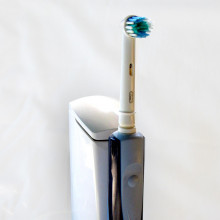
52:30 - Why does using an electric toothbrush alter my vision?
Why does using an electric toothbrush alter my vision?
We posed this question to Mikael Karlberg from Lund University Hospital in Sweden... Mikael - It's an interesting question, I noticed that phenomenon 10 years ago also while brushing my teeth, and watching television at the same time. I thought - this is very funny and then we did some experiments in front of computer screens, making a farting sound with your lips and watching the screen on the same time, and seeing exactly the same visual phenomenon. And then I specialized in inner ear disorders, on disorders of balance. We started to study the inner ear receptors, the vestibular receptors, that is the perception of vertigo, and the sensory cells are really small sensors that are sensitive to vibration, just like the auditory hair cells that make us hear.
It turned out, as I found in experiments from the 70s, that if you vibrate the skull and measure what the vestibular receptors do, they phase lock to the vibrations, so they start to signal with the same frequency as the vibration that is applied to the skull. So if you vibrate at 100 hertz, the vestibular cells start to fire at 100 hertz. So, what I believe happens is that we watch a screen and the screen is updated around 50 - 60 hertz, 50 to 60 times every second, and then we apply a vibratory stimulus to the vestibular hair cells, so they start to fire at a different frequency. And what we really notice here is some kind of interference phenomenon between the updating frequency of the screen and the vibration applied to the sensory hair cells. Chris - And what those vestibular system hair cells are actually doing is controlling your eyes so that the eyes move in the opposite direction to the movements your head makes. Now this is normally very important to help you to see objects clearly even when your head is moving around, but the vibrations from the electric toothbrush can disturb this control which makes the eyes move unnecessarily and consequently, the LED clock or the television, or whatever you're looking at, which is turning on and off very quickly, gets strobescopically caught by your moving eyes, the visual system, and the numbers appear to flicker.










Comments
Add a comment